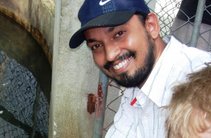PAINLESS - Total Knee Replacement
Total knee
replacement is a highly successful surgery. Patients disabled with knee pain
who can barely walk on their deformed legs undergone a dramatic transformation
after the surgery. They experience complete relief from pain and complete
correction of deformity. After surgery they don't need pain killers. They can
walk normally without a stick or walker and at a normal pace.
However the
surgery is a major procedure involving cutting of muscle and bone. This leads to
a slow and painful recovery. Post surgery pain after knee replacement can be
unbearable and remains as a major deterrent to someone who wants to undergo the
operation. Traditional methods of pain control include intravenous or
intramuscular analgesic injections and epidural pumps. Intravenous medicines
have safety issues and are not effective. Epidural pumps involve placing an
epidural catheter (a very thin tube) in the epidural space near the spinal
cord. Through this tube medicine is administered which numbs the spinal nerves
and relieves pain. A well functioning epidural pump is very effective but has
certain problems. Firstly, placing an epidural catheter is a blind procedure
and many times the catheter is not in an ideal position. As a result it fails
to reduce pain. Secondly, epidural pumps may cause a drop in blood pressure in
some patients which requires constant monitoring. Lastly, epidural medicines
may cause temporary sensory loss and motor weakness in the legs which makes
walking after surgery difficult.
In recent
years, technological advancements in the science of anaesthesia and pain
management have made painless knee replacement possible. Patients are
standing and walking by evening on the day of surgery! Nerve blocks are
a known technique of analgesia (pain relief). Two technologies have become
available to the anaesthetist in the operation theatre which have revolutionized the
efficacy of nerve blocks. First is a nerve locator. As its name suggests it
helps in precisely locating a peripheral nerve which then can be blocked by
administrating medicine. Second is portable ultrasound. Combining these
technologies increases the accuracy of locating a nerve to 95%. This allows the
anaesthetist to confidently block peripheral nerves (nerves outside the spinal
cord) with predictable success. In the case of knee replacement, a femoral
block and an adductor canal block is used to numb the pain. These blocks are
effective and safe. There is no drop in blood pressure and no motor weakness.
As a result we have successfully eliminated the need for epidural pumps.
Another
advance that we routinely use is called LIA - Local Infiltration Analgesia.
This involves injecting a combination of medicines in the local
tissues around the knee joint at the end of the surgery. With modern drugs and
optimal doses, this technique alone numbs the knee for 12 to 24 hours. Again
the technique is safe and effective. it does not
require monitoring of blood pressure and does not cause any
weakness.
The last
addition is that of pain patches. Newer opioid analgesics (artificial morphine
substitutes) are available as pain patches. A single patch
can work for a week. The action is not only long lasting but fast as
the medicine is directly absorbed in the blood from the skin (bypassing the
stomach).
Not only is
total knee replacement a highly successful surgery, it is now a comfortable and
pleasant experience as well. Today’s analgesia is safe and effective. All
patients are able to walk on the day after surgery and many manage to walk on
the same day. Nerve blocks, LIA and Pain Patches are so effective that they
have made painless knee replacement a reality today.




